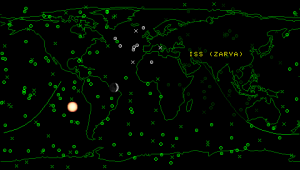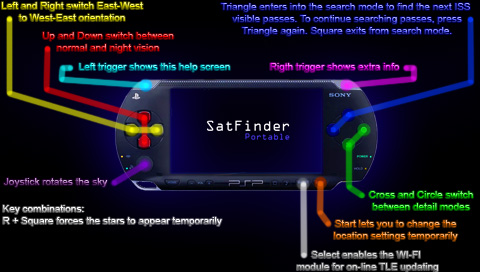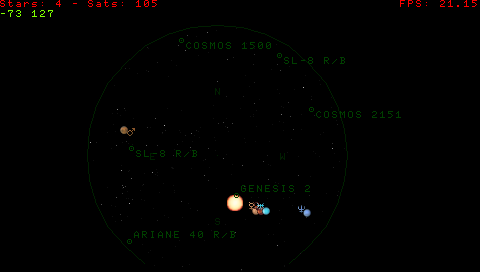More actions
| SatFinder Portable | |
|---|---|
 | |
| General | |
| Author | Pedro J. |
| Type | Other |
| Version | 1.3.2 |
| License | Mixed |
| Last Updated | 2008/09/01 |
| Links | |
| Download | |
| Website | |
SatFinder Portable is an astronomy application with its main purpose being a tool to find artificial satellites in the sky that can be seen with the naked eye. It is centered on the ISS (International Space Station), which id the brightest satellite on the sky.
If your hobby is seeing the stars, this is your homebrew. You can learn constellations, a lot of details about the sun and the moon, etc. It is available in English and Spanish, coded by Pedro J using Lua (includes source code).
It was submitted to the PSPUpdates Summer Homebrew Contest and the Scenery Beta 2008 (PSP Applications, 2nd place).
Installation
Note: It is advised to uninstall the previous version first, deleting the program directories in the GAME or GAME150 directory. The installer will find the previous versions and will not install the new one, simply keeping the TLE files updated online.
Connect your PSP to your PC vis USB and execute the accompanying installer SatFinderUpdater.exe to install SatFinder.
Once the installation process is finished, you will be asked to input the coordinates of your location.
It is essential to have internet from this point, as it will automatically look for updates and obtain information for the most visible artificial satellites from the Internet.
Tutorials written by developer can be found here and here (in Spanish).
User guide
What does it do?
- Determine the current position of the stars, the sun, and the moon in the sky. In addition, the moon is shown with its current phase. They will serve as a reference to visually locate the satellites.
- Determine when the next time the International Space Station (ISS) can be seen in your area will be.
- It has a voice assistant that communicates important events:
- When it is night or day.
- When the Sun or the Moon rises/sets.
- When a satellite appears above the horizon and there was not before.
- When a satellite appears above 30º of elevation and before there was none.
- When a satellite appears above 60º of elevation and before there was none.
- When a satellite appears above 80º of elevation and before there was none.
- When the ISS appears.
- When the ISS reaches its maximum elevation.
- When the ISS disappears.
- In addition, it always tells you in which direction you have to look: N, NE, E, SE, S, SW, W, NW.
Additional features
- Change the location of the observer both from the installer (it remains permanent), and from the PSP directly (but temporarily).
- Switch between day and night vision.
- Change the orientation of the sky.
- Show the name of the constellations.
- Possibility of updating TLE files online via WiFi.
The best time to see satellites
Generally after the sun sets for 2 or 3 hours and just before the sun rises (also for 2 or 3 hours) that the satellite is above the horizon, the sky be dark enough, and that the satellite is illuminated by the sun and not overshadowed by the earth.
Developer recommended to update the information contained in the TLE files periodically, at least before each observation, for the most accurate results.
3 classes of satellites (highlight)
The ISS (international space station) is a gigantic satellite compared to the rest, and its brightness is spectacular. It is the only one that can be seen regardless of the light pollution conditions in the sky. In the middle of Madrid you could see it without problems.
Normal satellites of brightness, although sometimes weak, assured. These are small satellites but they are very close to the earth (about 300 km high). Almost all satellites would go in here.
Satellites with indeterminate brightness (strong to weak), but not assured. This includes all the Iridium satellites, almost a hundred satellites that form rings and that are part of a bankrupt global telephone system. Due to the light they reflect, it is not enough to make them visible to the naked eye because they are further away (800 km high), but by having antennas that reflect the sun as if they were mirrors, it can give an intense shine that can last at least 20 seconds if said mirror is aligned with the sun so that it reflects its rays to where we are observing.
All Iridiums do not behave the same: some shine suddenly and others blink (they rotate on themselves quickly). The latter are Iridium out of order already out of control.
Controls
Triangle/Square - Search for next views of the ISS
Square - Cancel the search for ISS
Analog - Rotate map, Zoom
D-Pad - Switch between day and night vision
L - Show World Map
R - View extra information
Cross - Sky detail configuration
Circle/Cross - Show the name of the constellations
Select - Update of TLE files by WIFI
Start - Change the location of the observer
Screenshots


Changelog
version 1.3.2
- Luaplayer changed. Now is used HW7 RC1.
- Corrected an small error when showing coordinates in the Information Screen.
- Corrected an infinite loop when we try to update TLE files using WIFI. Now if you can't find a proper point of access, you are returned to the main screen.
- Moon phases are in UTC time format. A label has been added to avoid confusions.
- Iridium satellites now can be disabled. Added this option in the options screen.
- Adapted in order to participate in the Scenary Beta 2008 contest.
version 1.3.1
- Improved the download of TLE files via WIFI. Now it takes much less time.
version 1.3
- Changed the LuaPlayer used to LuaPlayerHW6.5 WIFI EDITION.
- Corrected the function that calculated lunar phases (erroneous in version 1.2).
- Incorporated useful information into a top bar:
- Battery status.
- Limiting magnitude of displayed stars.
- Frames per second (FPS).
- Zoom status.
- Rotation status.
- Time (hour, minutes, and seconds).
- Changed the appearance of the information screen.
- Added an update of the position and trails of all satellites when a long time has passed without drawing. A warning message appears: "Updating satellites..."
- When selecting a specific satellite from the list of upcoming satellites to be viewed, its path in the sky is traced, and you are notified when it will appear.
- The program closes much faster (due to the new LuaPlayer).
- Improved the calculation of the percentage of lunar disk illumination.
- Stars illuminate more when zoomed in.
- WIFI functionality works on both FAT and SLIM.
- Available in English and Spanish (already translated, AeroPSP).
- Sound issues fixed.
version 1.2.1
- Improvements in the graphical environment.
- Fully compatible with PSP Slim (except for net download).
version 1.2
- Complete visual overhaul with everything drawn based on a configurable color scheme.
- Fully mobile celestial vault with unlimited zoom.
- New system for searching ISS sightings.
- New system for searching sightings of any satellite in the next half hour.
- New configuration screen with persistent settings.
- Day and night color configuration options.
- Screenshots saved to the PICTURE directory.
- New method for drawing satellite trails. They are fully drawn from the beginning, no need to wait for satellites to move.
- Ability to trace the path of a satellite across the celestial vault.
- Configurable number of stars to display by changing the limiting magnitude.
- Constellations with full names.
- Comprehensive documentation available in manuals on the official website.
- Add a link in the favorites list of our PSP browser, for easier access.
version 1.1 Beta
- TLE file download via WIFI is functional.
- New data screen accessible by pressing R.
- New world map screen accessible by pressing L. It displays all satellites positioned around the world, with the ISS highlighted and showing its trajectory for the next hour.
- Sky detail configuration: Pressing X allows selection of desired sky elements. Disabling stars or satellites does not work, but other options do.
- Zoom with the joystick up and down. It is centered on 90 degrees and cannot be freely moved. Useful for cities with limited sky view.
- Sky rotation with the joystick left and right. Useful for keeping the console stationary.
- Audible and textual announcement of sunrise and sunset times.
- Prediction of sunrise, sunset, moonrise, and moonset times.
- Prediction of night start and end times.
- Prediction of moon phases.
- New informed startup system.
- Corrected moon position, which was erroneous in version 1.0.
- Fixed other issues from version 1.0.
- New, more elegant/simple installation system, extendable to all languages.
version 1.0
- Initial release.
Credits
Razorblade, Dr. TSKelso, John Walker (Home Planet) and John A. Magliacane (Predict).
External links
- Author's website - http://perso.gratisweb.com/pedroj.fernandez
- SceneBeta - https://psp.scenebeta.com/noticia/satfinder-portable
- ElOtroLado - https://www.elotrolado.net/hilo_satfinder-portable-1-0-sale-a-la-luz_851635
- QuickJump - http://forums.qj.net/showthread.php?t=144468 (archived)
